
Mary Pearl is the president of Wildlife Trust, cofounder of its Consortium for Conservation Medicine, and an adjunct research scientist at Columbia University. This week, she’s traveling in the Galapagos Islands of Ecuador with a boat full of scientists, conservationists, and business leaders to forge partnerships and develop solutions to the global freshwater crisis. This is the second of her dispatches from the journey. See her first dispatch here.

Our first afternoon hike was spectacular: an extravaganza of lovesick blue-footed boobies and vermillion-throated magnificent frigate birds displaying to potential mates on North Seymour Island. The sea lions were strewn like boulders on the beach, except for the pups, who either raced around in rough-and-tumble play, or inched up to inspect human beings with their big eyes and little, whiskery snouts.

The next morning, Manu Lall spoke to us about water after we re-boarded the Isabella II fresh from swimming and snorkeling at Gardner Bay at Espanola Island. Manu is a professor of engineering and hydrology at Columbia, and his assignment was to present the current state of the world’s water. He started off with this startling statement: If water use continues as it is today, we can expect a catastrophe somewhere between 2026 and 2050.
The action agenda for addressing climate change, a synergy of science and political activism, is to find solutions before a climate crisis overwhelms us and leads to irreversible damage, he told us. The time scale is in decades. But here we are with water crises looming even closer, a subject about which there is relatively little research and even less dialogue.
Manu predicted that the number of over-appropriated water basins is increasing exponentially all over the world. He suggested that we advance the term “hydrologic change” to match the phrase “climate change,” to refer to the collection of local concerns about water that need our urgent action.

Unlike climate change, however, hydrologic change will be much more difficult to address by a single global policy or technology fix, because the crisis is a collection of localized disasters. Farmers in northern India are pumping groundwater for irrigation at such a rapid rate that it is likely to run out in a decade, leading to a collapse of agriculture and population. This is seen as an Indian problem. The Yellow River in China no longer runs to the sea; this is a Chinese problem. The three-day walk for poor-quality drinking water is an Ethiopian problem. The pollution of the Long Island, N.Y., aquifer is only a problem to those who live above it.
It is curious that we put the water crisis on the back burner in this way, at least compared to climate change, because many significant uncertainties remain with climate change. Alarmingly, the hydrologic cycle is a very weak link in climate-change projections. Scientists estimate that global groundwater supplies range from 7 million to 330 million cubic km. In other words, we simply don’t know the supply. This is a basic problem that gives rise to other gaps, such as how water availability will change, and how the distribution of water through the atmosphere and vegetation may itself cause changes in climate.
Glaciers are melting, aquifers are drying out, droughts are worsening, and the population continues to grow. Grist readers are familiar with this litany. A search on Google for the term “water crisis” yields almost a million hits. Conduct the same search on Google Scholar, the search engine for scientific papers, and the number of hits is only around 4,000. Most of these, Manu adds, pertain to policy rather than urgently needed in-depth research.

There is no time to lose, because we are facing not one but three water crises. The first is scarcity. The second crisis is one of access, as in Ethiopia, where poor people lack the infrastructure to obtain clean water. The third is the crisis of pollution that results from resource use, both in terms of toxicants and pathogens, as we’ve seen with the Long Island aquifer. Of these three, the issue of access to safe drinking water is perhaps the easiest to solve, because we know how to deliver it and can quantify success in terms of numbers of people served. What is needed is political will and the impetus to give support to poor communities. The issue of pollution is tractable to some degree, when its source is identifiable. We know how to treat most water so it can be reused, and research is being done into ways of controlling emerging chemicals. The ongoing challenge here is when pollution comes from diffuse sources such as farms or the atmosphere.
So we conclude that depletion of water below what is needed to sustain life is the scariest problem. The Brazilians in the group note that each day the Amazon pours into the ocean enough freshwater to provide nine years’ worth of water for all of New York City. Claudio notes that since last year, water is no longer free in Brazil, and the proceeds of sales go to the watershed communities that own them. The problem of scarcity seems far away from Brazil, until Manu starts to talk about soybeans. In China’s soybean-growing area, the water table has dropped anywhere from three to ten feet. So now, instead of importing water directly to grow the crop, the Chinese are importing massive amounts of water via Brazilian soybeans! In fact, of the total amount of water in agricultural products in trade today, fully one-quarter is from a country other than where the food is consumed. We discover that we are shipping water globally on a large scale.
All the participants are suddenly on common ground: where the science of water scarcity meets the global marketplace.
Now the conversation turns to solutions to scarcity. Tomorrow, we will discuss the ones we can implement today and others that are still in experimental stages.
Go to Mary Pearl’s third dispatch.




